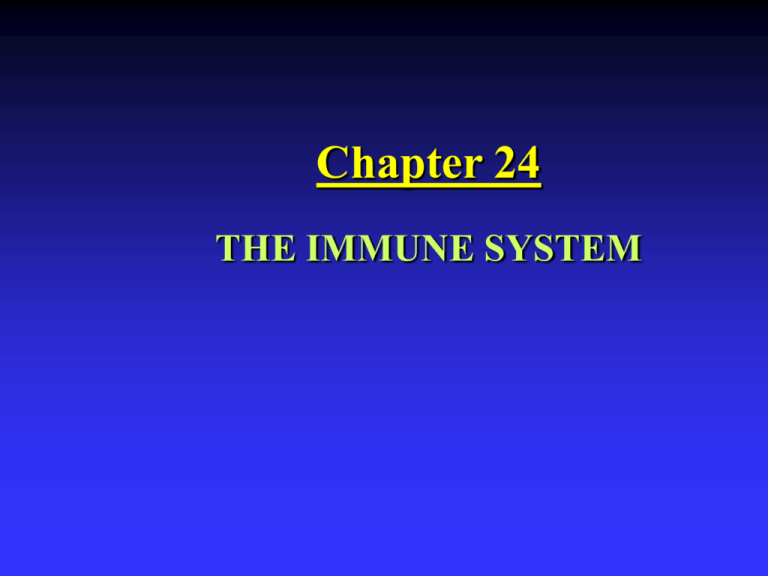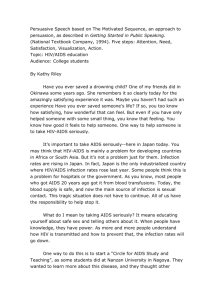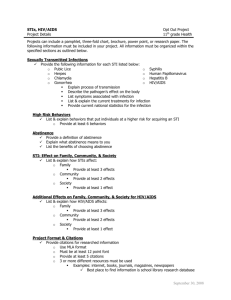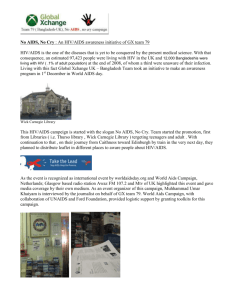I. Introduction to class
advertisement

Chapter 24 THE IMMUNE SYSTEM Introduction Resistance: Ability to ward off disease. Nonspecific Resistance: Defenses that protect against all pathogens. Specific Resistance: Protection against specific pathogens. Susceptibility: Vulnerability or lack of resistance. Protection Against Invading Pathogens 1. First Line of Defense: Non-specific natural barriers which restrict entry of pathogen. Examples: Skin and mucous membranes. 2. Second Line of Defense: Non-specific defenses that provide rapid local response to pathogen after it has entered body. Examples: Fever, phagocytes (macrophages and neutrophils), inflammation, and interferon. 3. Third line of defense: Antigen-specific immune responses, specifically target and attack invaders that get past first two lines of defense. Examples: Antibodies and lymphocytes. Defenses Against Infection First Line of Defense: Skin is an Effective Barrier Against Infection by Most Pathogens Second Line of Defense: Interferon is Nonspecific Inhibitor of Viral Infection Inflammation is a Nonspecific Defense 1. Damaged cells release chemical signals: Histamine and other molecules. 2. Local response to chemical signals: Increase in local blood flow and vascular permeability Redness Heat Swelling Pain 3. Phagocytic white blood cells come into area: Engulf bacteria, dead cell parts, and other microbes. 4. Tissue heals Inflammatory Response: Nonspecific Defenses Third Line of Defense: The Immune Response Immunity: “Free from burden”. Ability of an organism to recognize and defend itself against specific pathogens or antigens. Immune Response: Involves production of antibodies and generation of specialized lymphocytes against specific antigens. Antigen: Molecules from a pathogen or foreign organism that provoke a specific immune response. Lymphatic and Immune System Components: Lymph, lymphatic vessels, bone marrow, thymus, spleen, and lymph nodes. Functions: Defends against infection: bacteria, fungi, viruses, etc. Destruction of cancer and foreign cells. Synthesis of antibodies and other immune molecules. Synthesis of white blood cells. Homeostatic Role: Returns fluid and proteins that have leaked from blood capillaries into tissues. Up to 4 liters of fluid every day. Fluid returned near heart/venae cavae. Lymphatic System The Immune Response Destroys Specific Invaders Antigen: Molecule that elicits an immune response. “Antibody generating”. Microbial antigens: Viral capsid, bacterial call wall, etc. Nonmicrobial antigens: Pollen, latex, food, etc. Antibody: Protein found in blood plasma that attaches to antigen and helps counteract its effects. Vaccination or Immunization: Process in which harmless forms of antigen or pathogen are introduced into body to provoke an immune response. Lymphocytes Mount a Dual Immune Defense 1. Cell Mediated Immunity Immunity that requires cell to cell contact. Carried out by T cells: Develop in the thymus. Only recognize antigen associated with self-protein. T cytotoxic cells: Important in defense against: Cancer cells Self cells infected with fungi, viruses, protozoans, and bacteria. T helper cells: Play a central role in immunity. Act indirectly by controlling the immune functions of other cells: Increased antibody production by B cells. Increased phagocytosis by macrophages. Increased killing of foreign and cancer cells. Development of T and B Lymphocytes T helper cells play a central role in immunity Lymphocytes Mount a Dual Immune Defense 2. Humoral (Antibody Mediated) Immunity Antibodies Blood Lymph Interstitial fluid Antibodies are found in our body fluids: are produced by B cells. B cells develop in bone marrow. Antibodies are specific molecules that circulate through out our body and attach to foreign antigens, marking them for destruction. Foreign antigen does not have to be associated with a self antigen to be recognized. Antibodies can be passed from one individual to another: Mother-child: Mother’s antibodies cross placenta. Also found in breast milk. Serum: Snake bite antivenom. Antibodies are Protein Molecules that Recognize Specific Foreign Antigens Antibodies Help Eliminate Foreign Antigens Acquired Immunodeficiency Syndrome (AIDS) History 1950s: Blood samples from Africa have HIV antibodies. 1976: First known AIDS patient died. 1981: First reports of “Acquired Immunodeficiency Syndrome” at UCLA. 1983: Virus first isolated in France. 1984: Virus isolated in the U.S. 1985: Development and implementation of antibody test to screen blood donors. History (Continued) 1986: Virus named Human Immunodeficiency Virus (HIV-1). Related virus (HIV-2) identified. 1992: AIDS becomes the leading cause of death among adults ages 25-44 in the U.S. 1998: AIDS death rates start to decline in U.S. due to the introduction of new drug cocktails. 1999: Over 33 million HIV infected individuals. Another 16 million have already died from AIDS. 2000: World Health Organization predicts up to 40 million infected individuals. AIDS Becomes a Leading Cause of Death Among People Aged 25-44 years in U.S. 40 35 30 25 AIDS Accidents Cancer Homicide 20 15 10 5 0 1982 1986 1990 1994 Deaths per 100,000 people aged 25-44 years People Living with HIV/AIDS by End of 1999 North America 920,000 Western Europe 520,000 East Europe & Central Asia 360,000 East Asia & Pacific 530,000 North Africa & Middle East 220,000 Latin America 1.3 million South/South East Asia 6.0 million Sub-Saharan Africa 23.3 million Total: 33.6 million people Australia & New Zealand 12,000 Transmission of HIV (Worldwide) 1. Sexual contact with infected individual: All forms of sexual intercourse (homosexual and heterosexual). 75% of transmission. 2. Sharing of unsterilized needles by intravenous drug users and unsafe medical practices: 5-10% of transmission. 3. Transfusions and Blood Products: Hemophiliac population was decimated in 1980s. Risk is low today. 3-5% of transmission. 4. Mother to Infant (Perinatal): 25% of children become infected in utero, during delivery, or by breast-feeding (with AZT only 3%). 5-10% of transmission. Perinatal Transmission of AIDS Source: Tropical Medicine and Parasitology, 1997 Characteristics of all viruses Acellular infectious agents Obligate intracellular parasites Possess either DNA or RNA, never both Replication is directed by viral nucleic acid within a cell Do not divide by binary fission or mitosis Lack genes and enzymes necessary for energy production Depend on host cell ribosomes, enzymes, and nutrients for protein production Unique Characteristics of HIV Retrovirus: Unique enzyme reverse transcriptase, converts viral RNA into DNA. Genetic material: 2 strands of RNA. Integrase: Inserts viral DNA into host DNA. Protease: Processes viral proteins. Essential for maturation. Envelope with glycoproteins: Viral capsid is covered by envelope derived from host cell membrane. Envelope contains a glycoprotein (gp120) which attaches to CD4 receptor on host cell membrane. Coreceptors: Required for HIV infection. CXCR4 and CCR5. Structure of the Human Immunodeficiency Virus HIV is a Retrovirus Life Cycle of HIV 1. Attachment: Virus binds to surface molecule (CD4) of T cells and macrophages. Coreceptors: Required for HIV infection. CXCR4 and CCR5 mutants are resistant to infection. 2. Fusion: Viral envelope fuses with cell membrane, releasing contents into the cell. 3. Reverse Transcription: Viral RNA is converted into DNA by unique enzyme reverse transcriptase. Reverse transcriptase RNA ---------------------> DNA Reverse transcriptase is the target of several HIV drugs: AZT, ddI, and ddC. HIV Life Cycle: Reverse Transcriptase Converts RNA into DNA Life Cycle of HIV 4. Integration: Viral DNA is inserted into host cell chromosome by unique enzyme integrase. Integrated viral DNA may remain latent for years and is called a provirus. 5. Replication: Viral DNA is transcribed and RNA is translated, making viral proteins. Viral genome is replicated. 6. Assembly: New viruses are made. 7. Release: New viruses bud through the cell membrane. Course of HIV Infection Definition of AIDS AIDS is a syndrome: A collection of several diseases and symptoms that differ from one individual to another, but point to severe immunosuppression. HIV Antibody positive and one of the following (partial list): Kaposi’s sarcoma Pneumocystis carinii pneumonia HIV dementia non-Hodgkin’s B cell lymphoma Yeast infection of esophagus, trachea, or lung Multiple bacterial infections in children <13 years Tuberculosis of the lung* Recurrent pneumonia* Invasive cervical carcinoma* All HIV+ persons with <200 CD4+ cells/ul* *Added January 1, 1993. AIDS Associated Disease Categories 1. Gastrointestinal: Cause most of illness and death of late AIDS. Symptoms: Diarrhea Wasting (extreme weight loss) Abdominal Infections pain of the mouth and esophagus. Pathogens: Candida albicans, cytomegalovirus, Microsporidia, and Cryptosporidia. African AIDS patient with slim disease Source: Tropical Medicine and Parasitology, 1997 Opportunistic Oral Yeast Infection by Candida albicans in an AIDS Patient Source: Atlas of Clinical Oral Pathology, 1999 AIDS Associated Disease Categories 2. Respiratory: 70% of AIDS patients develop serious respiratory problems. Partial list of respiratory problems associated with AIDS: Bronchitis Pneumonia Tuberculosis Lung cancer Sinusitis Pneumonitis Chest X-Ray of AIDS Patient with Tuberculosis AIDS Associated Disease Categories 3. Neurological: Opportunistic diseases and tumors of central nervous system. Symptoms many include: Headaches, peripheral nerve problems, and AIDS dementia complex (Memory loss, motor problems, difficulty concentration, and paralysis). AIDS Associated Disease Categories 4. Skin Disorders: 90% of AIDS patients develop skin or mucous membrane disorders. Kaposi’s sarcoma • 1/3 male AIDS patients develop KS • Most common type of cancer in AIDS patients Herpes zoster (shingles) Herpes simplex Thrush Invasive cervical carcinoma 5. Eye Infections: 50-75% patients develop eye conditions. CMV retinitis Conjunctivitis Dry eye syndrome Extensive tumor lesions of Kaposis’s sarcoma in AIDS patient. Source: AIDS, 1997 Chronic Herpes Simplex infection with lesions on tongue and lips. Source: Atlas of Clinical Oral Pathology, 1999. Non-Hodgkin’s Lymphoma & ascites in AIDS patient Source: Tropical Medicine and Parasitology, 1997 Drugs Against HIV Reverse Transcriptase Inhibitors: Competitive enzyme inhibitors. Example: AZT, ddI, ddC. Protease Inhibitors: Inhibit the viral proteases. Prevent viral maturation. Problem with individual drug treatments: Resistance. Drug Cocktails: A combination of: One or two reverse transcriptase inhibitors One or two protease inhibitors. Drug cocktails have been very effective in suppressing HIV replication and prolonging the life of HIV infected individuals, but long term effectiveness is not clear.








